If you have made up your mind to have a planted tank, then freshwater plants had to be the basis of the inspiration.
Plants for aquarium are an underwater garden, though a few plants may be allowed to grow out from the aquarium’s surface and penetrate the atmosphere with its leaves and flowers.
Also, some terrestrial plants may be positioned so that their adventitious roots may actually enter the aquarium. It is the natural tendency of rooted plants for their roots to seek water and they grow in the direction of the source of water.
As a general rule, pet shops that specialize in aquariums also carry live plants. The best plants are usually those that are grown in small plastic pots and you have the ability to buy them in a rooted condition. These plants have usually been grown under hydroponic conditions, where the food is liquid.
When you get the plant home you should remove the pot but keep the roots embedded in the ball of glass wool (or whatever the base medium is) and plant the entire ball and roots together. You can also keep live plants in the plastic pot, but then their growth is severely restricted. But this restriction of growth may be desirable in some cases.
To state the case simply, the goal of a planted tank is to achieve a great visual depth. This is also the case in many paintings and photographs. How to depict a three-dimensional view in two dimensions (drawings, paintings, etc.) has been achieved by famous artists throughout history.
Since few of us are landscape geniuses, we have to rely upon the general principles of the golden intersection in order to achieve our goals of depth perception.
There are many plants suitable for the aquarium. Many, if not most, are bog plants and live better out of the water than they do submerge. It is even possible to use land plants for certain purposes, but you must realize that such plants ultimately die and can cause pollution havoc in the aquarium.
Here Are Our Best Plants for Your Freshwater Aquarium
Saururus Cernuus (Lizard’s tail)
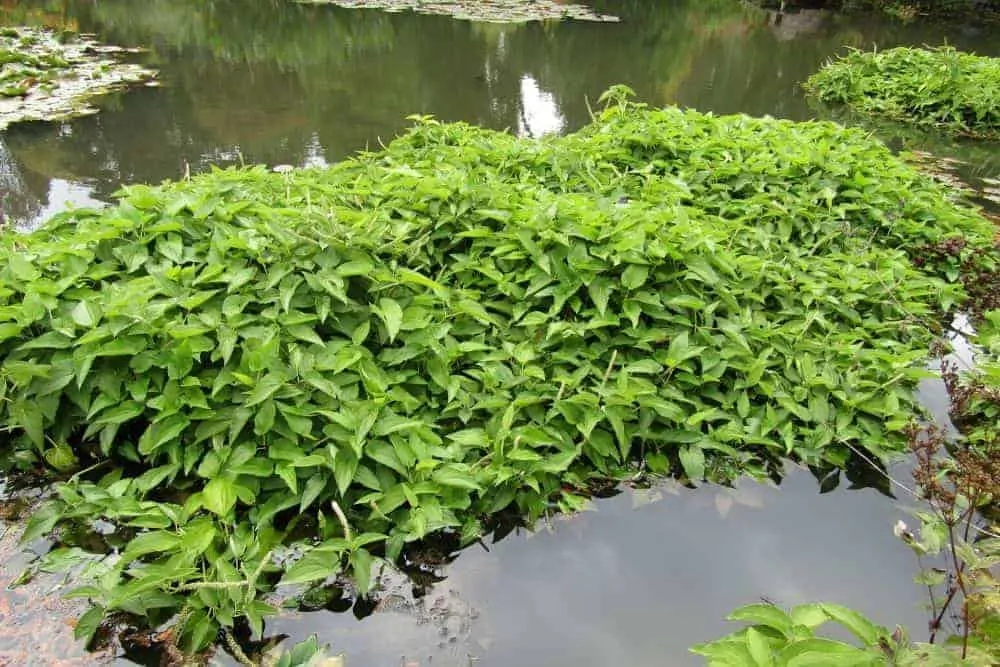
Many aquarium designers use Saururus Cernuus for their foreground plant. WRONG! While this is a very lovely plant it may require a lot of work. If used in the foreground, the plants must be changed to smaller plants every few weeks, depending upon the growth rate.
This is most easily done by having a special swamp tank or plant aquarium with strong light and fertilizer in which plants are grown to be transplanted into the Dutch aquarium. In the case of Saururus, growth is convenient. The head of the mature plant is removed and allowed to float under intense light.
Within two weeks, your plants have sprouted. These young plants are then used for the foreground of our Dutch aquarium. When these grow too large, they are removed and the sequence starts again.
The larger Saururus are used in other parts of the aquarium where the terracing (slope) demands plants of that height. Saururus is a plant that needs plenty of light.
If it is light-starved it will become stringy and lackluster and will certainly be unfit for the foreground of the aquarium. Because Saururus is so fast-growing when it has enough light, the substrate must have some clay or other nutrients in it. Plain sand or gravel has absolutely nothing that a plant can use as a nutrient.
Add fertilizer to the substrate if you want phenomenal looking Saururus. Your pet shop can supply you with aquarium fertilizer. You should really learn as much as you can about Saururus because it can be used in almost every aquarium situation, even mixed with other plants, because it is so bright green when healthy and the leaves are so nicely formed.
Lobelia Cardinalis (Cardinal Plant)
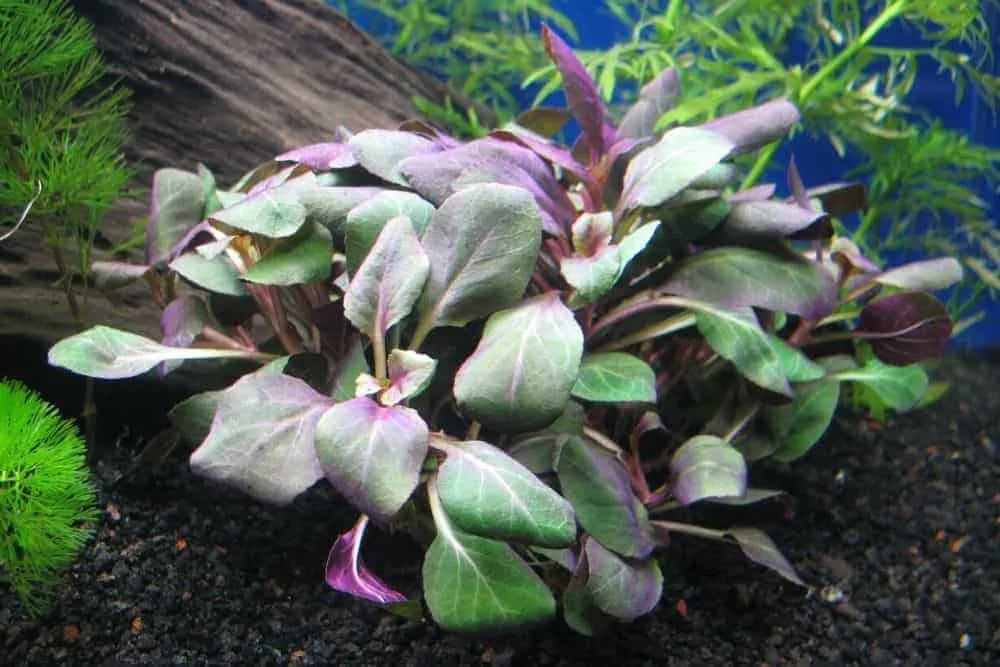
Lobelia cardinalis is a frequently used foreground plant. Because it is a stalk plant and a bog plant (just like Saururus), it is often used in the aquarium. However, Lobelia is not suitable as a foreground plant, it is slightly too large and obscures too much of the front view and combats the sloping effect we are trying to achieve to create the feeling of depth in our Dutch aquarium.
To grow properly, Lobelia cardinalis requires a substrate with unwashed gravel which contains some peat and clay. Being a bog plant it needs a lot of light. Underwater it grows much more slowly than when grown under bog conditions (bog conditions are when the plant is rooted in soaking wet mud covered by less than an inch (2 cm) of water, with the leaves growing in the air).
When Lobelia grows properly, the leaves are almost an inch (2 cm) broad and 2 inches (5 cm) long, including the stem.
Lobelia in the aquarium requires constant pruning. If planted in bunches, which should be about 3 inches tall, constant pruning is required. The plants should not be allowed to reach the surface of the water. They should always be an inch below the water’s surface.
To keep them from growing quickly, remove their roots before planting them in the aquarium. As they develop roots, they will also develop new shoots on the old stalks. These new shoots are removed when they reach about an inch or two (up to 5 cm).
However, if possible and practical, leave the plant alone and let nature take its course. Sometimes pruning or picking off the Lobelia’s new leaves injures the root, which might be catastrophic for the plant.
Because of this growth potential, do not plant Lobelia, too closely together. Each leaf needs its own source of strong light. If you plant them too closely, some leaves will shade others and the plant will grow poorly from a visual point of view.
The Lobelia in your aquarium must have all of its leaves bright green. The leaves in the shade will turn light green and then brown and eventually die. You don’t want this to happen, so you plant them less densely.
Elatine Macropoda
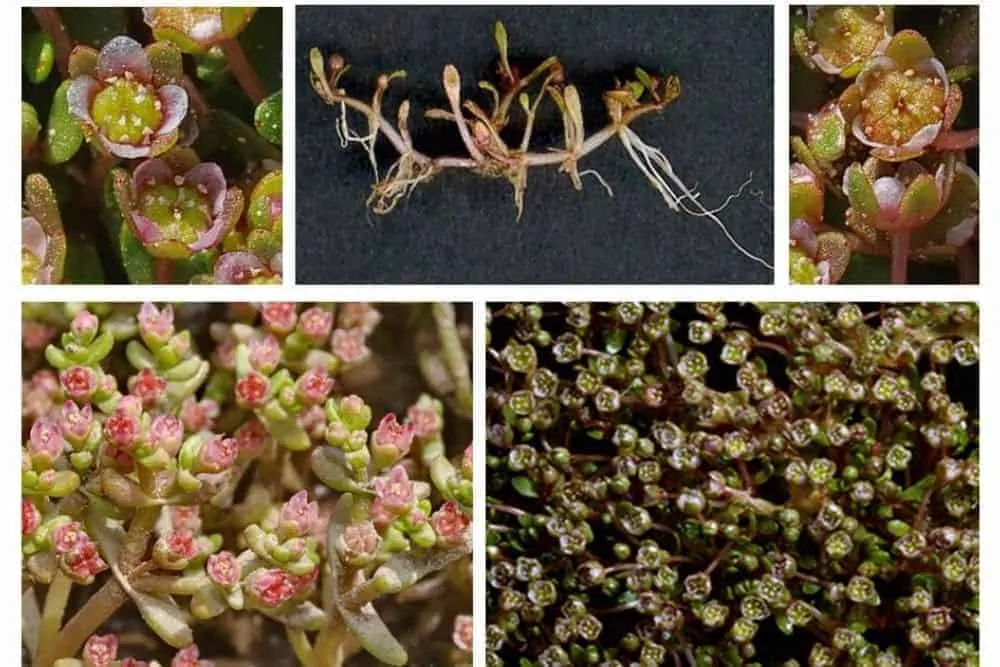
An extraordinarily useful plant, not often seen in pet shops, is Elatine macropoda. This plant does well against the front glass with the sloping gravel making it appear taller as it recedes from the front glass, where it can meet up with a dense planting of a taller plant.
Elatine has the same light and nutrient requirements as Lobelia and Saururus. This plant has leaves of almost a half-inch (1 cm), which grow on thin stalks and creep along the bottom. While it does best in soft water with a pH above 7.2, it has been known to thrive in harder water with as much hardness as 12° German hardness (DH). The stalks of this plant are very delicate and break easily when handled. Use small planting tongs (tweezers).
Echinodorus Tenellus
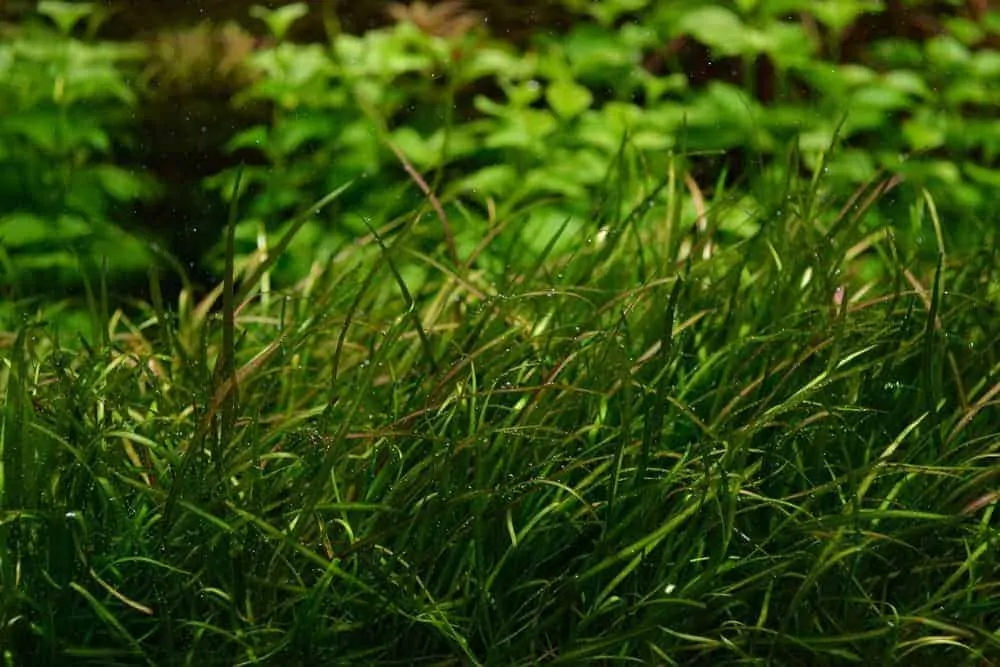
Another plant that builds interesting foreground mats is the dwarf sword plant known scientifically as Echinodorus Tenellus. It reproduces quickly and easily by runners. As with the previously mentioned plants, this plant needs lots of light and some fertilization.
Because they are so fast-growing, plant them initially 2 inches (5 cm) apart. Use large tweezers to plant them so the roots are not tommed apart. Do not use Echinodorus Tenellus with other plants that reproduce by runners. Otherwise, the plants will intrude upon each other’s growing space.
If the adventitious roots infiltrate other areas (where your initial design has it reserved for some other plant), take a long-handled scissors and cut the adventitious (wandering) roots and remove them from the tank.
Heteranthera Zosterifolia
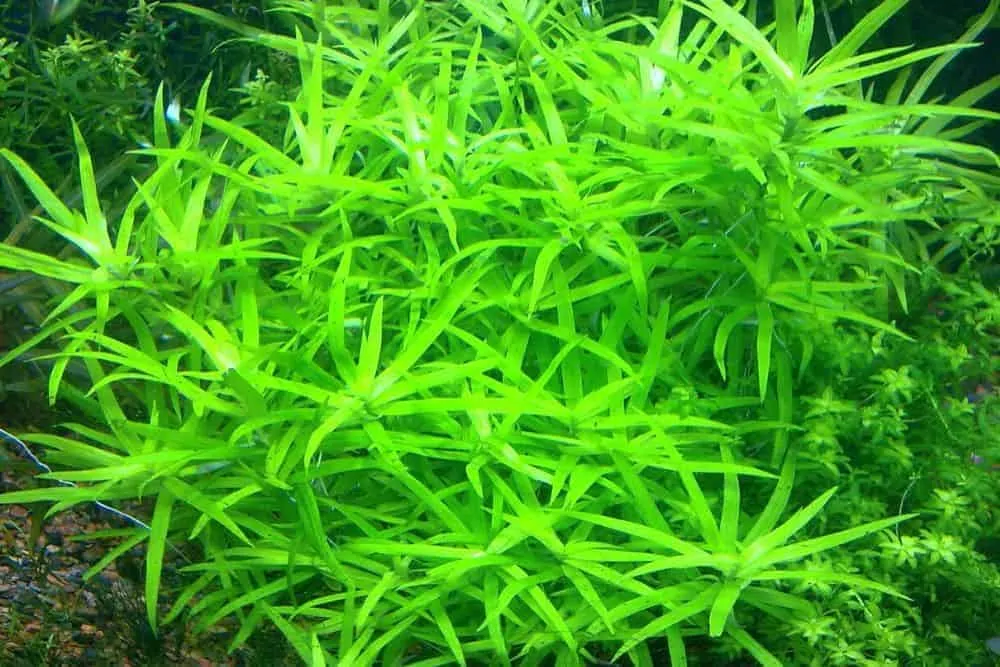
Heteranthera Zosterifolia is a favorite aquarium plant because it is so easily available and grows well without a special fertilizer or substrate. It does, however, need a lot of light, as do most fast-growing plants. To keep the plant small, we continuously behead it (pinch it back).
New shoots will constantly reappear at the site of the detachment. It is best to behead the plant about one inch (2 cm) from the bottom. In this way, a deep, bright green field will develop.
Heteranthera can easily be used to butt against other short plants, or even against large, taller plants, as shown in the accompanying photograph. Don’t expect such lush growth without lots of light! This is also true for Proserpinaca Pectinata (Hottonia inflata).
Tetra AquaSafe Plus, 8.45 Ounces, aquarium Water Conditioner And Dechlorinator, Model Number: 46798162681 (Pack of 1)
$8.49 (as of October 20, 2024 08:04 GMT +03:00 - More infoProduct prices and availability are accurate as of the date/time indicated and are subject to change. Any price and availability information displayed on [relevant Amazon Site(s), as applicable] at the time of purchase will apply to the purchase of this product.)API STRESS COAT Aquarium Water Conditioner 4-Ounce Bottle (85B)
40% OffTetra 16172 AquaSafe Fish Tank Water Conditioner, 8.45 fl oz
39% OffWithout a lot of light, all these plants will do poorly, and instead of presenting a nice foreground lawn for the aquarium, they will present an unimaginably bad impression.
Bolbitis Heudelotii (African Water Fern)
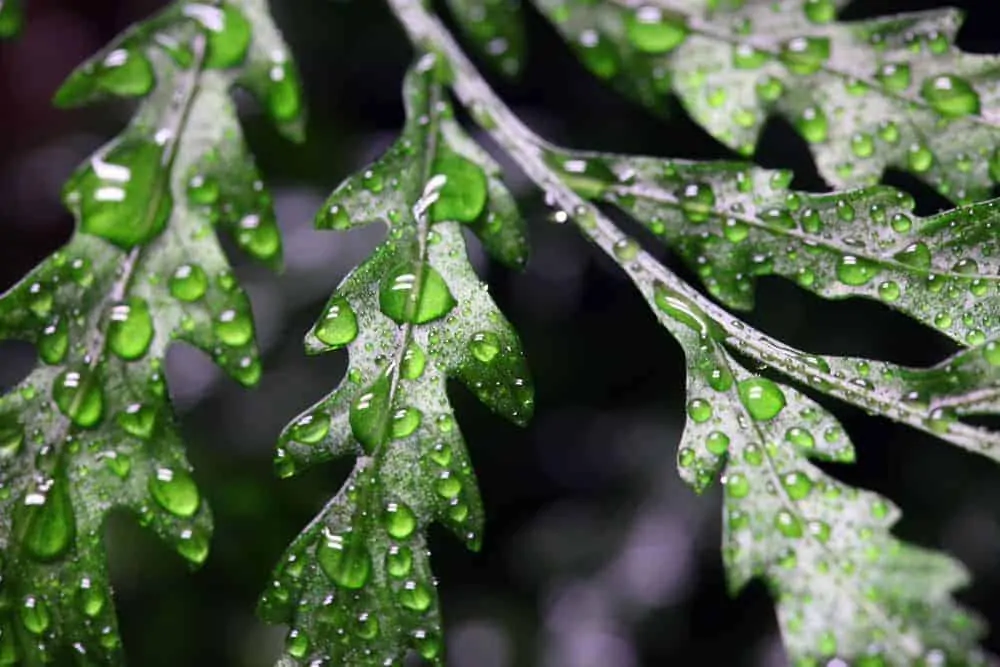
Bolbitis Heudelotii is also easily fastened to walls or bogwood. This African Water Fern can be used in different ways, for example as a shadow provider on the wall, because this plant needs low light. In strong light, it will grow much slower than under moderate light (light-factor 0.25). We fasten it to a free-standing piece of bogwood with which it should have enough space to grow.
Under optimal growing conditions, this fern becomes rather big, although with some experience it can be held at bay. It is thinned out by cutting the roots. We should be careful when doing this to an older species because most of the time they are firmly anchored to the bogwood.
This plant is very useful as a look-through to intensify depth perception. It not only has contrasting dark green leaves against other plants, but it also grows somewhat “loosely.” Therefore, it does not build dark, close groups.
If we have a diagonal look-through consisting of bright green plants, in one of the comers, as a “street,” then we create a roof at the other end by B. heudelotii at three-quarters of the height of the wall, or a towering piece of bogwood at the end of the “street.” At the top, we can have Hemianthus micranthemoides grown just underneath the surface of the water, for this needs much light and will shade the Bolbitis underneath.
Anubias
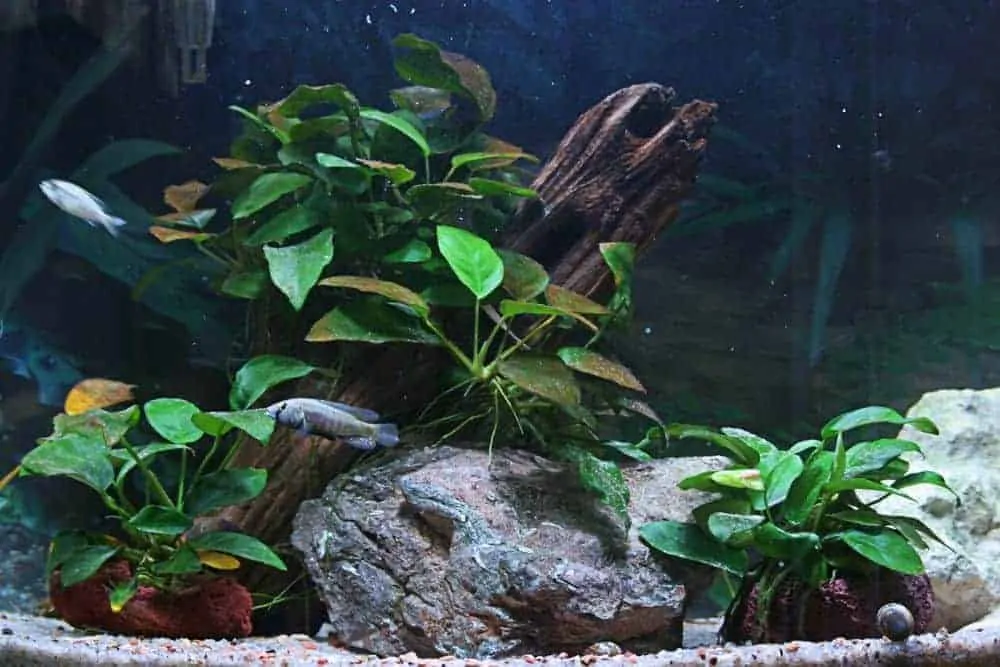
We will get the best depth by making the right choice and building an adjoining plant on either side. If we let a bright green “street” go through a group that is a middle green, we use Anubias nana and minima.
We want to use the peculiar way they anchor themselves to stone by means of their crawling rhizome. In nature, they often grow in dense fields at the stony banks of brooks.
The trade offers Anubias in small perforated plastic containers, filled with stone or nylon wool, which comes from a hydroculture. We leave the Anubias in the container, take a piece of fem root made as a plank, cut a hole in it the size of the container and fix this together flat on the bottom.
Now the container is secured in the hole. The rhizome of the Anubias crawls over the fem root and fixes itself. Waste will collect at the same spot, and the Anubias will grow excellently when the lighting is right. The plant can be easily moved if necessary.
Crinum Natans
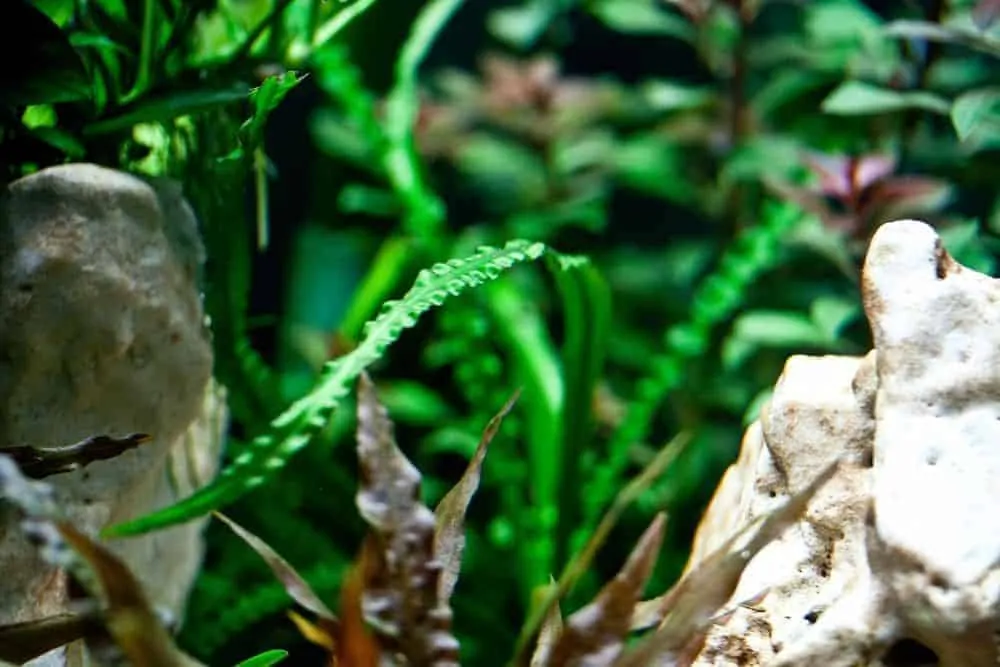
In nature, we find Crinum Natans both at very deep and shallow places. This plant becomes very large and builds a dense tangle of roots, so it can only be used in spacious aquariums.
It is best planted in a container with loose sediment with a bit of clay and iron. As a group of plants (three plants are enough!) in a comer of the aquarium, they will grow, dependent on the light, and become strong specimens that will push their leaves along the surface of the water. It is not well suited for an aquarium with a length of one meter and a depth of fifty centimeters.
Cryptocoryne
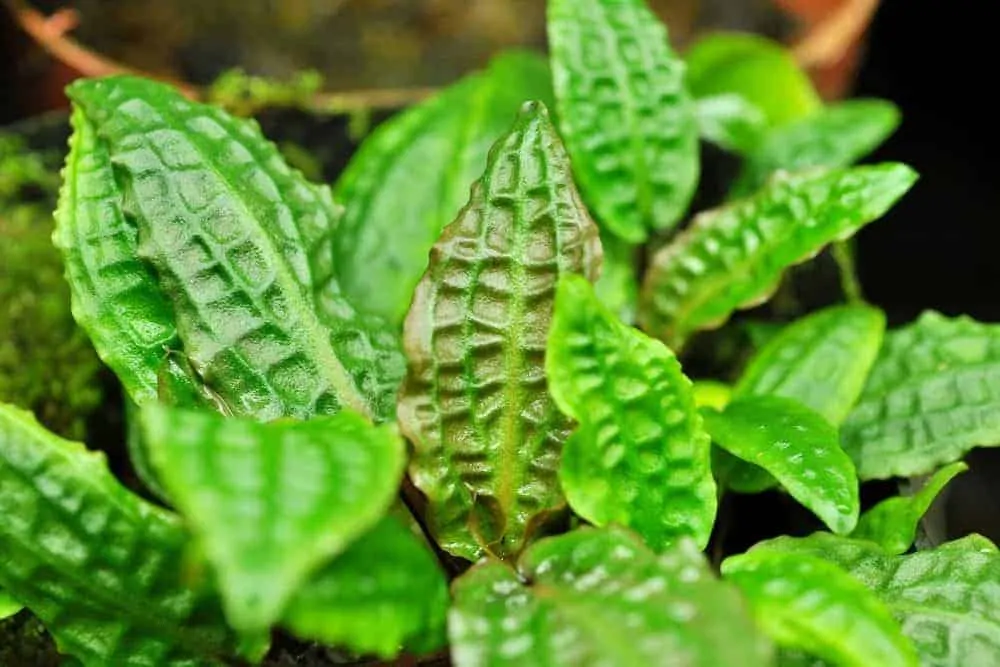
We use the same principle with Cryptocoryne Ciliata as a free-standing solitary plant. Once planted, Cryptocoryne ciliata should be left in peace. Often the plant will flower when left alone in the same place for three years or more.
Self-pollination of the flower underwater will produce a fruit with over 40 seeds. These are scattered on a very loose bottom made out of gravel with a diameter of 4 millimeters and mixed with some clay.
We leave the height of the water at approximately 4 centimeters and light it well for at least 12 hours a day. As soon as the leaves reach the surface of the water, we heighten the water level somewhat. Older plants of Cryptocoryne ciliata, which stand always at the same spot in the aquarium, also reproduce vegetatively.
In this way, they become, over the years, a very nice group. Out of the axil of most of the dying leaves, young plants will grow. However, if the leaves turn yellow do not remove them at once, but wait.
When the old leaf is completely rotted away, we do not tear off the young plants right away, for they are about 5 centimeters and have no roots.
We plant the young plants very carefully in a raising tank. Unwashed sand will be enough. We thank the Dutch hobbyist Vlasblom for the first instructions on how to propagate C. ciliata.
He even grew a triplet shoot. He then planted the shoot with several structures at the bottom. At the top, the young plant developed with roots. If there were enough roots, he cut off the shoot just below where the roots grew, planted it and left the rest of the shoot.
Often one or two more offshoots then developed out of the nodes. As a rule, we should leave Cryptocoryne in peace, because after replanting they take some time to build new roots and runners.
We plant them in containers with a mix of unwashed sand, some soil for flowers, and peat, then put the container in water just as far as the top of the soil and pay attention to the heat and humidity.
Almost all of the named species endure the sun very well. C. willisii (the old nevillii) loves a little diffuse light, just like C. zewaldae, which in nature also does not like harsh light. In a culture outside the water, the plants build either faster (C. becketii) or slower (C. zewaldae) large amounts of roots, or far-reaching runners.
Many species of Cryptocoryne have various forms, and we know three forms, that differ in length and width of their leaves. We also know of three forms with C. becketii, and especially C. wendtii that have very variable forms in leaves and color.
In our aquarium, the low growing C. wendtii is the nicest. From the genus Cryptocoryne, we have another beautiful solitary plant named C. crispatula. It is best suited for somewhat deeper (50 to 60 centimeters) aquariums.
We buy the plants small, as they are mostly offered at a length of approximately 15 to 30 centimeters. We plant them in free space in the middle part, and under good light, they will reach a height of approximately 50 centimeters and put out runners.
If these are somewhat grown we cut them off, plant them again close to the mother plant, and in this way create a beautiful solitary group. With this plant, we can interrupt a large swimming space so that the fish have to swim around it. As an eye-catching object this plant, two centimeters in width, band-shaped, and with middle green colored leaves, is highly decorative.
Aponogeton Undulatus & Aponogeton Ulvaceus
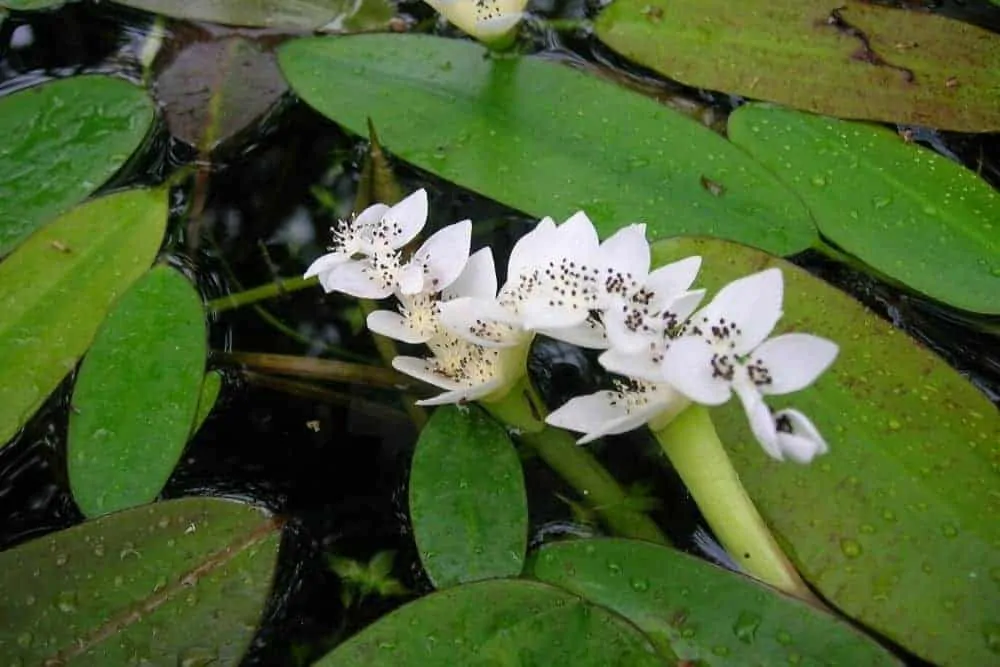
The same is possible with Aponogeton undulatus, although it does not grow runners. Because of the small form of the leaves, Aponogeton undulatus works very decoratively. Its method of multiplying is interesting. It develops small bulbs on a stalk, which is where the young plants grow out of.
We should not remove them right away but should wait until more of them have grown with enough roots. Often only one young plant grows out of each stalk. Unlike Aponogeton Undulatus, Aponogeton Ulvaceus is a giant, with corrugated leaves that are 5 centimeters broad and about 30 centimeters long.
As a solitary plant, it needs much more room. This goes also for the smaller A. echinatus. We cover the stalks of these species by a half-circle of low growing plants, although the bottom of the stalk should have a space of approximately 10 centimeters in diameter.
A. ulvaceus fits perfectly in low growing groups, as its leaves curve as a broad crown over the other plants. A. echinatus and ulvaceus are often confused by many aquarists.
If they flower, then this mistake is impossible. A. echinatus has a single axil and a white spadix, whereas A. ulvaceus has a double axil which, because of its more than rich pollen, looks yellow. Species of Aponogeton need a rest period just as Barclaya and Nymphea species.
With many species, it is necessary to move the bulbs across the bottom or they will die, for instance, like A. Hoivinianus. This very beautiful plant, which is only useful in large aquariums, should never be planted too close to other plants.
Aponogeton should never be planted too close to the wall because they do not develop too well. This works better with Ottelia Alismoides, which in the aquarium is used as a solitary plant, but also can be used at the sides. This difficult plant needs warmth and good light.
Very clear water is a necessity, and the soil should be nourishing. To get this we mix unwashed sand, clay peat, and pot soil in even parts. If well lit, the plant will flower in the aquarium.
Echinodorus
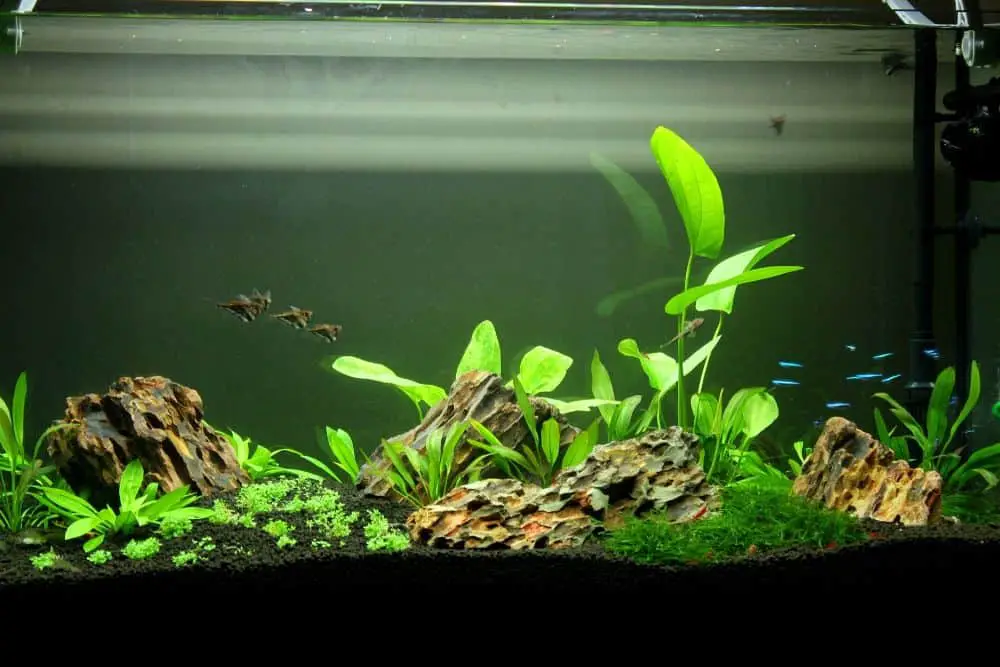
The genus Echinodorus offers the most species for solitary or group planting. They have many different leaf forms. The narrow-leafed Amazon Sword Plant, E. amazonicus, which, in larger aquariums, are also used as a group plant, is well known.
Others are E. bleheri, the broad-leafed Amazon Sword Plant, a typical solitary plant in the open space, or alone upon a terrace in the middle of a bloom of E. maior (formerly E. marii) or E. osiris The red Amazon Sword Plant and E. berteroi, the beautiful cellophane-plant, which also needs much room, especially when standing alone, works very decoratively.
It is not good to have a plant jammed into a group. Totally different leaf forms are found in E. cordifolius (formerly E. radicans) and E. radicalis. Echinodorus is a swamp plant that grows taller than one meter.
Nevertheless, it is useful in the aquarium, as we nurse it as a wreathed form. For best results, we grow it in a soil of unwashed or even washed sand. It is best planted in a container, otherwise if left to grow freely it will send its roots everywhere. If we then want to remove it from the aquarium, it will become chaotic.
As soon as the plants grow leaves on their long stems, we should cut them immediately. Echinodorus cordifolius has nice oval leaves that look like rosettes.
It is the most decorative in an open space or resting against a corner on a terrace wall. E. horizontalis has fewer problems. The leaves are in the form of a heart and grow almost at a 90-degree angle from the stem.
For this reason, we are able to recognize the plant immediately. It needs more light than E. cordifolius, and should stand free and be left in peace. Just like all Amazon Sword Plants, E. horizontalis grows a flower on which young shoots develop.
When these are strong and have grown some roots, we can cut them. E. cordifolius, E. maior, and E. osiris are propagated in the same way. To avoid further growth difficulties, we bend the stem with the young plants to the bottom and anchor them with stones.
If they grow further, we should push them a little deeper, so that the plants have their roots right on the bottom. We leave them alone for approximately three months, at which time they become strong enough and we can plant them in another spot, where the light intensity is right.
No species of Echinodorus should be planted too deeply. If there are not enough old roots to plant, we carefully tie them to a stone or a piece of lead, which is carefully folded around the foot of the stalk. Then we protect it with a piece of polystyrene.
Bacopa Caroliniana & Bacopa Amplexicaulis
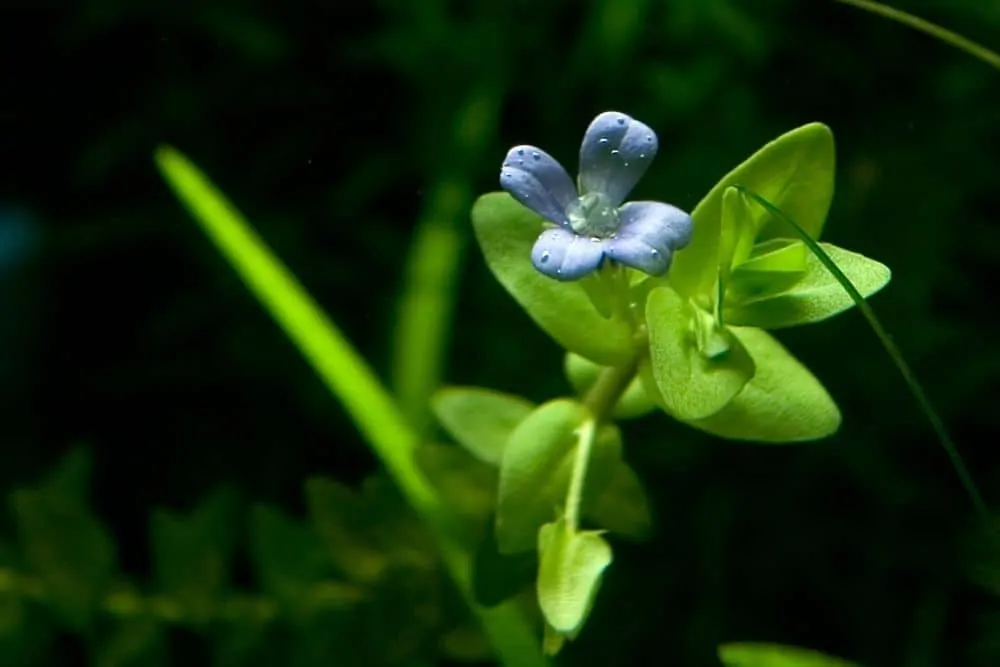
Species of Bacopa offer smaller or larger groups in the margin, or even standing free. Bacopa caroliniana (syn. B. amplexicaulis is better as B. monnieri, which likes it a bit cooler, although it is also found in Southeast Asia. B. Caroliniana looks bright green, middle green with reddish veins or completely red, depending on the care taken. Both species need lots of light, and we should plant their stems one by one.
Cabomba
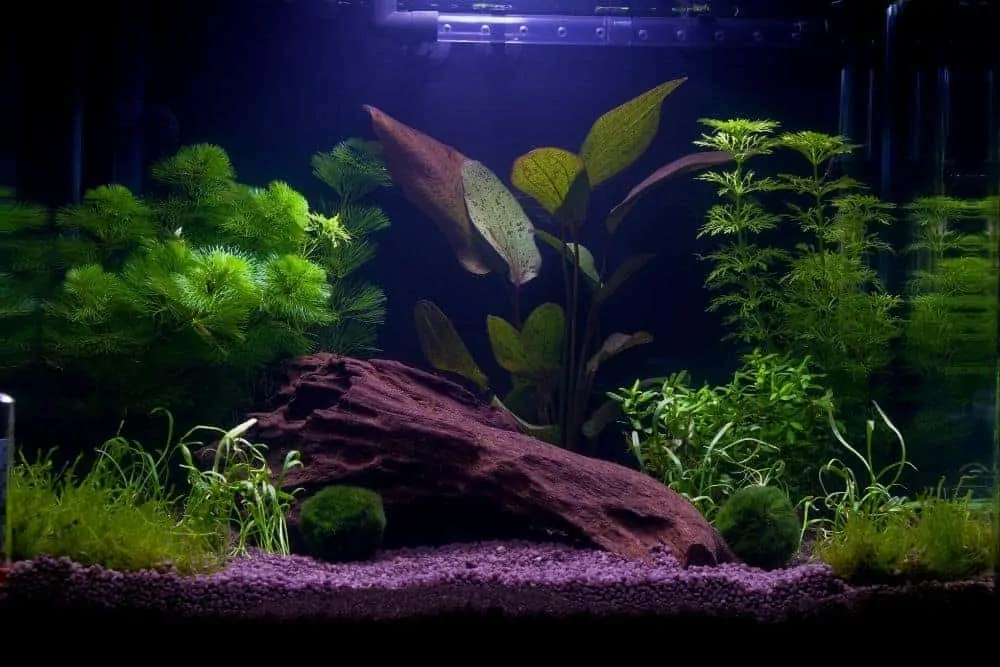
With Cabomba- species we plant three stalks in each plant hole. Cabomba caroliniana is the easiest, C. aquatica is more difficult, and C.furcata (syn. C. piauhyensis the red Cabomba, often gives problems. They all demand crystal clear water, free of particles.
In addition, the latter three need soft water. Red Cabomba often dies after the planting, but the rest can have roots again and give new shoots, which will flower under high light. They should not be overshadowed by other species.
Eleocharis Acicularis
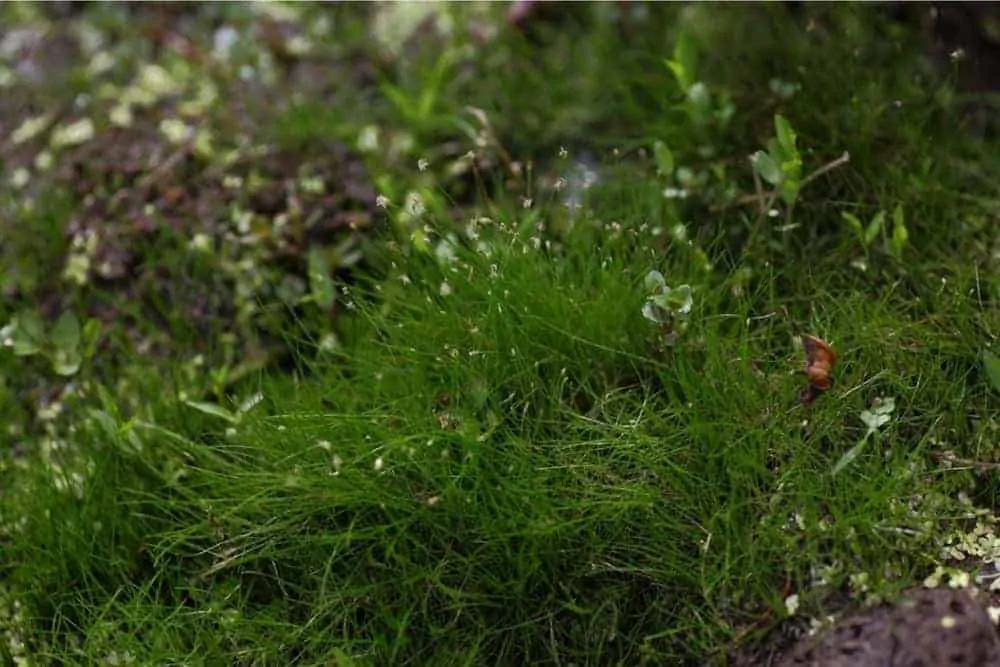
Eleocharis acicularis is very usable as a wall made out of plants. It needs clear water, not too much light (danger of algae!), and will grow in different heights, often just as a five-centimeter high “lawn,” but often as high as 15 centimeters.
It is planted (with a pair of tweezers) in small bushes with approximately two centimeters in between. By means of outlets, it will build a dense stock. We should make sure that it will not mix with neighboring plants. These runners are removed, and if it still becomes too dense we must remove some of the plants.
Hygrophila Polysperma & Hygrophila Corymbosa
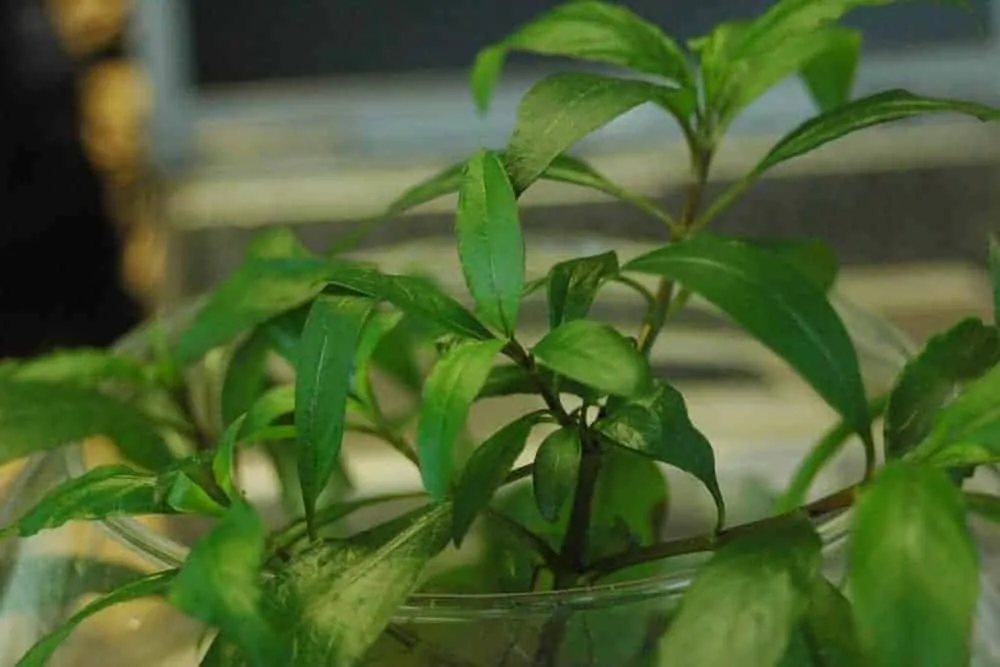
Species of Hygrophila, like Cabomba, can be reproduced. We put Hygrophila Polysperma, but also many other plants with supple stalks, onto the bottom and weigh down the ends to prevent the plant from upending itself.
Young plants will emerge from each leaf axil. When they become approximately ten centimeters long, we cut the stalk. However, do not pinch off the young plants! In this way, we will have a large stock from just a few stalks. H. corymbosa (syn. Nomaphila syncta) is easily reproduced if we remove the top and leave the old stalk.
Shoots will develop from here, even at the breaking spot of the stalk. At approximately 8 centimeters we take the rooted shoots off and plant them. H. corymbosa needs room to develop and should not be planted too closely together. In the larger aquariums, we plant them in rows and shift the planting holes.
Limnophila Aquatica
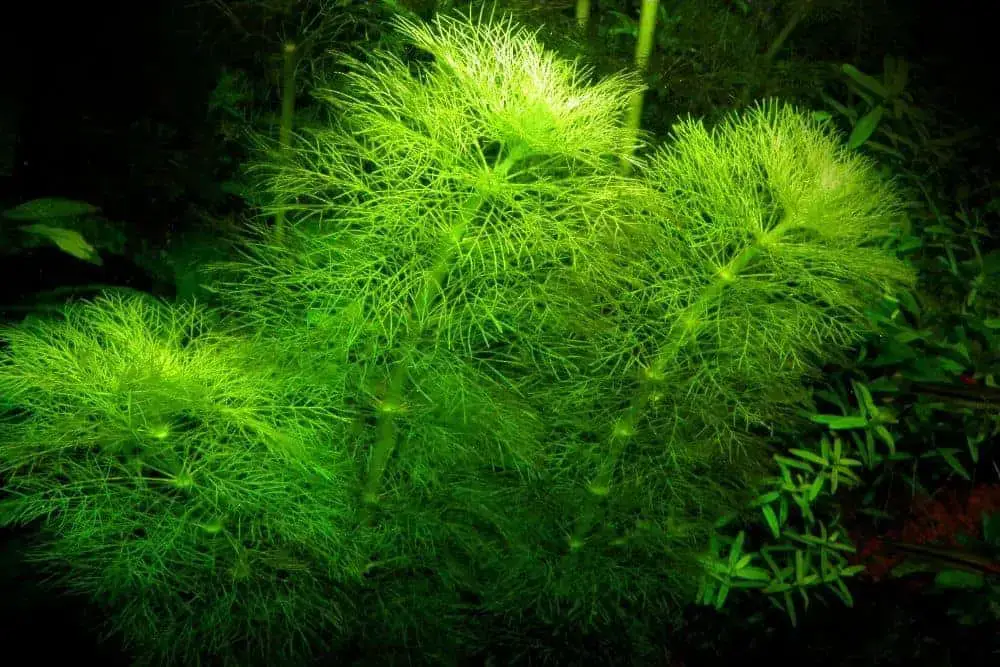
Limnophila Aquatica is the best known Limnophila species. In each plant hole we put one stalk, about 6 centimeters apart and shift the rows. This plant needs a great deal of light and not too hard, clear water, then it will leave garlands that are over ten centimeters broad.
We give this very beautiful group plant unwashed sand with an additional 30% clay. It often suffers from chlorosis. In that case, iron-based fertilizer is necessary.
Ludwigia
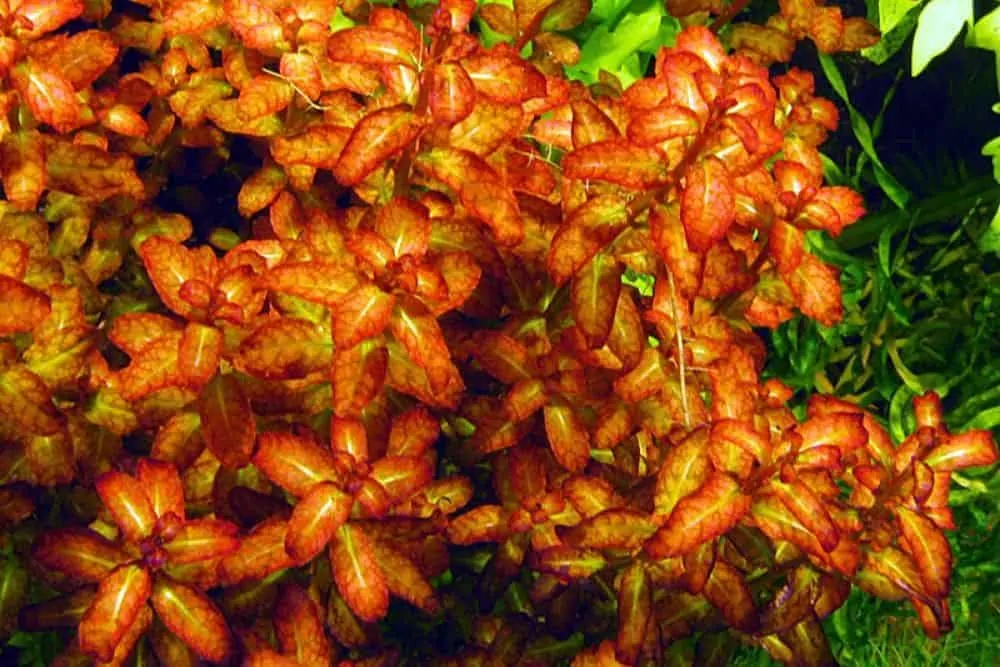
Also, with the Ludwigia species, we plant only one stalk in a plant hole 4 centimeters apart and shift the rows. When the light is hot enough it often loses its lower leaves.
Good strong light produces green to red/ brown leaves with strong reddish undersides. They are easy to multiply, as it forms many side shoots. If the bush becomes too thick, we should thin it out. The addition of iron fertilizer works wonders.
Myriophyllum
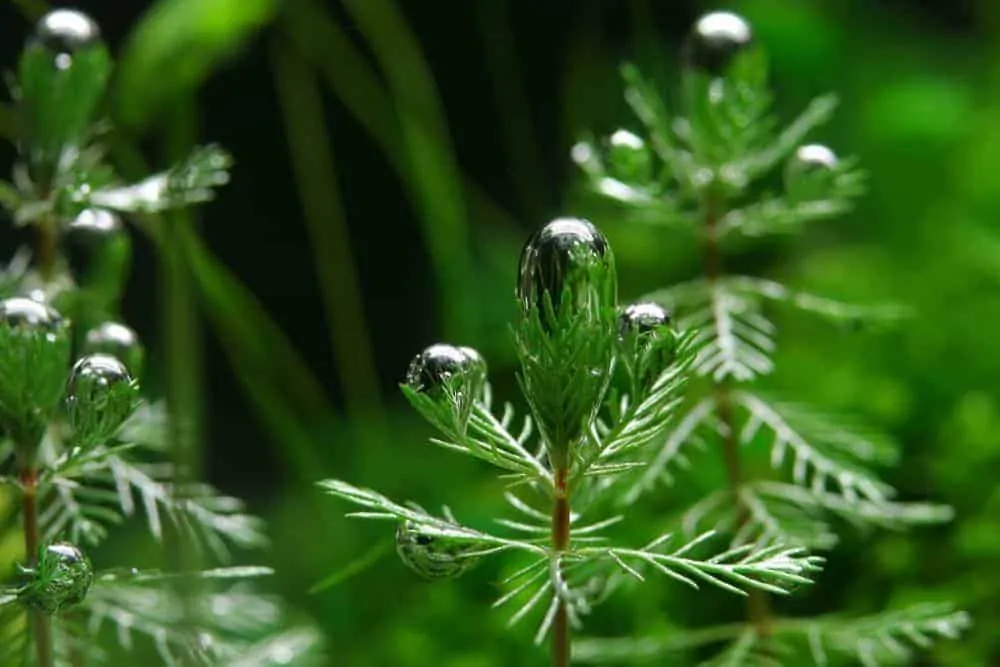
Myriophyllum species, in general, have great light demands. Myriophyllum matogrossense demands the most light. It reacts very strongly to floating particles in the water, becomes soiled quickly and then dies.
This species is best used on a higher terrace. If we leave it to grow as garlands out of the comer or somewhere out of the fringe plants, it does not work very decoratively, but does serve as a spawning place for those inhabitants that live at the surface of the water, such as Epiplatys species.
M. aquaticum (syn. M. Brasiliense) is less sensitive, has green-leafed garlands, and can, as all species from this order, be planted with three stalks in one plant hole.
If they grow at the surface of the water, the Myriophyllum species often grow side shoots, so that we have to thin them or they develop too strongly.
Najas
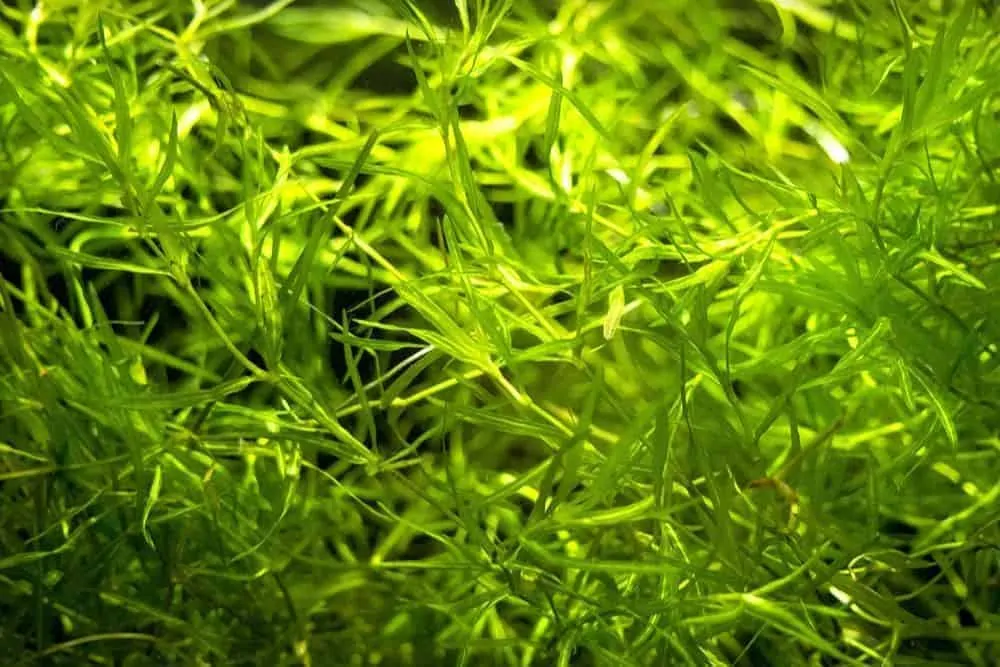
Species of Najas should not be planted. We keep them at the bottom with a small piece of lead foil that is carefully wrapped around a few stalks with a piece of foam material.
Very carefully we let them sink onto a terrace, as most of the Najas are very fragile and are, as a rule, only used as floating plants. However, they build beautiful free-standing groups in the fringe areas with the lead method. The nicest species is Najas Microdon, which not only looks decorative but also offers spawning areas for many fish species and refuge for young fish, just like other floating plants.
Rotala Wallichii & Rotala Macrantha
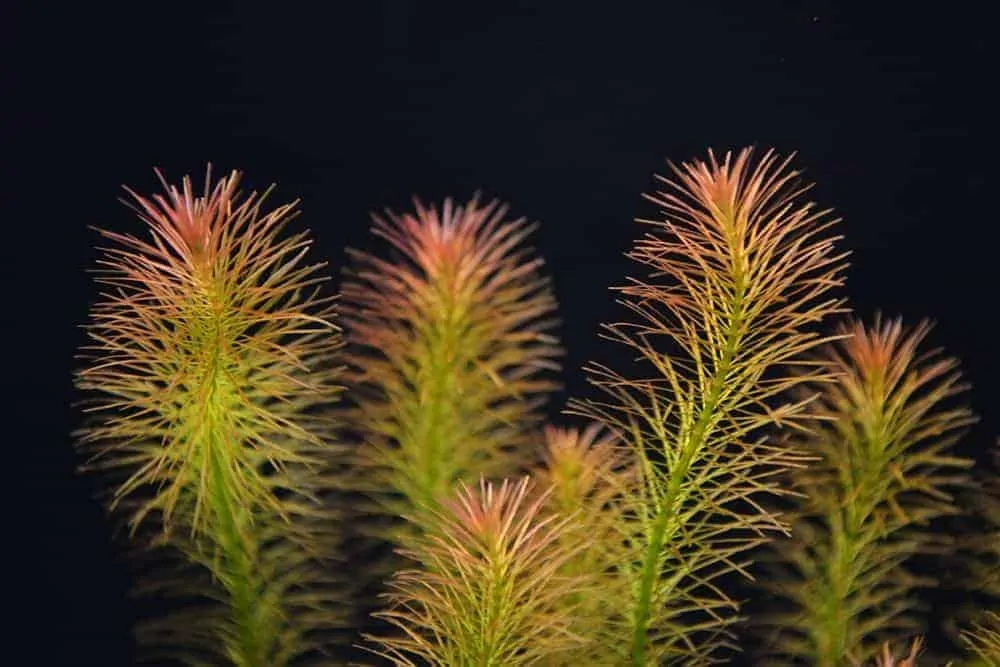
A completely different form of leaves than already discussed is seen in Rotala wallichii and is shown by Rotala macrantha. It is too bad that this very decorative plant is not very easy to grow, but perseverance and effort will be rewarded by beautiful red/brown to pink colored leaves.
We should plant the stalks five centimeters apart, one by one, and shift the rows. They need good light. If given it, they grow very well and even build garlands along the surface of the water.
They do not like shade, and also the leaves of stalks that stand beside each other should not hinder each other. Rotala needs a soil with an addition of clay and iron-based fertilizer. It breaks easily and should be planted with care.
Vallisneria Gigantea
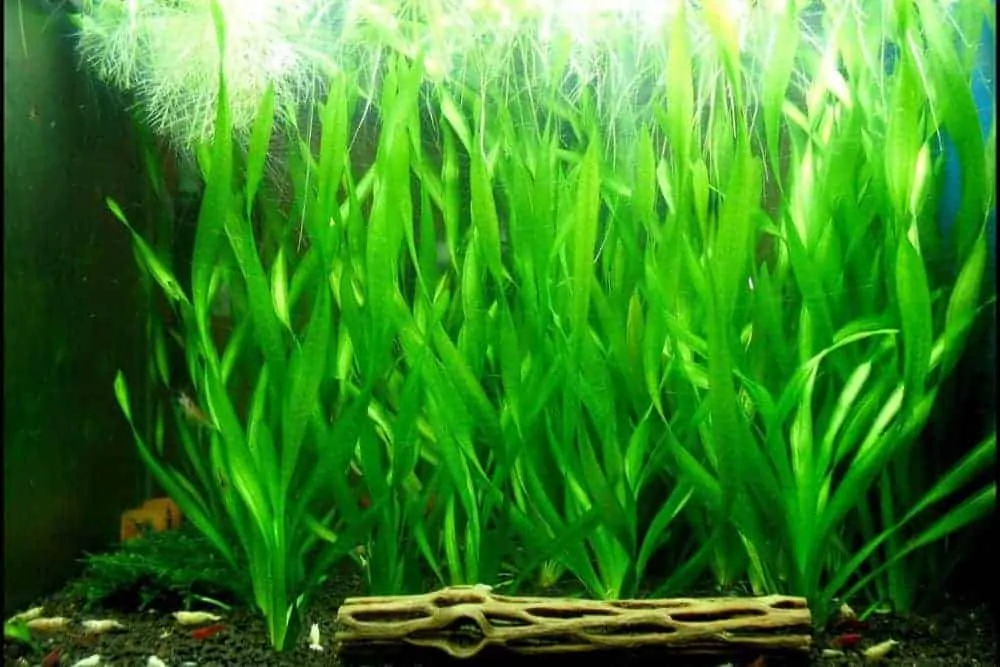
Besides the already mentioned species, I would like to name Vallisneria Gigantea, the green giant, and V. neotropical, the red giant. They both can only be used in large aquariums in a comer.
Under enough light, their leaves grow along the surface of the water, but they take light away from the plants that grow underneath. They demand water that is medium-hard. In general, all aquarium plants can be damaged when planting, and they often die.
A plant should never just be pushed into the bottom, but a hole should be made with a finger, the plant carefully put in. and the hole closed gently. We cut the roots of all plants with a sharp knife. Depending on the species, we remove one to three pairs of leaves and plant the stalk as far as 5 centimeters into the bottom.
All species are planted in such a way that the root is just covered. The roots are not removed, because they anchor the plant into the bottom. If this does not work, we can use a piece of lead foil.

Hi, my name is Sean, and I’m the primary writer on the site. I’m blogging mostly about freshwater and saltwater aquariums, fish, invertebrates, and plants. I’m experienced in the fishkeeping hobby for many years. Over the years I have kept many tanks, and have recently begun getting more serious in wanting to become a professional aquarist. All my knowledge comes from experience and reading forums and a lot of informative sites. In pursuit of becoming a professional, I also want to inspire as many people as I can to pick up this hobby and keep the public interest growing.
Read more about Sean.
Please join also my Facebook group.

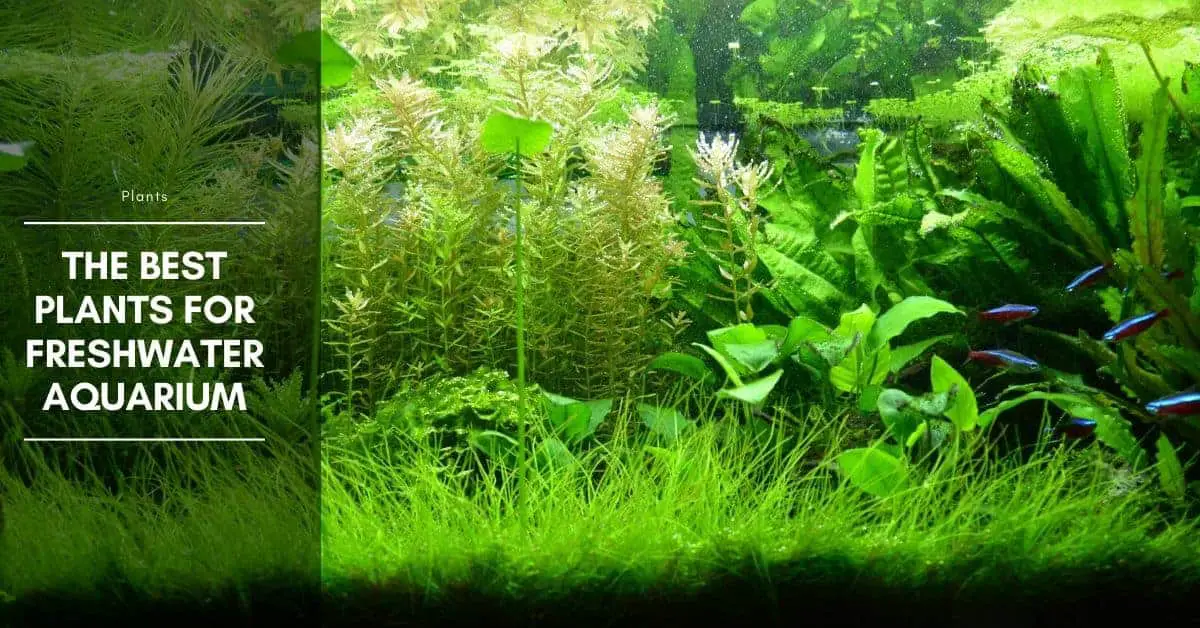


















1 thought on “21 Best Plants for Freshwater Aquarium”
Comments are closed.